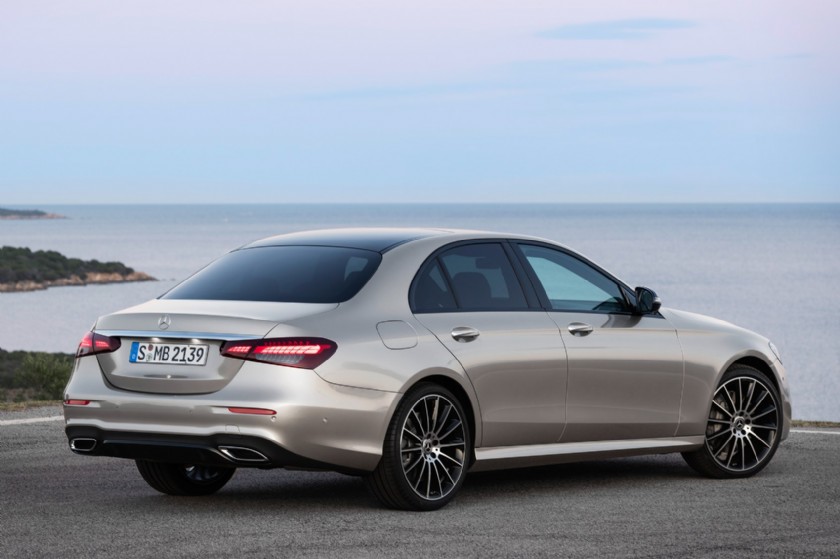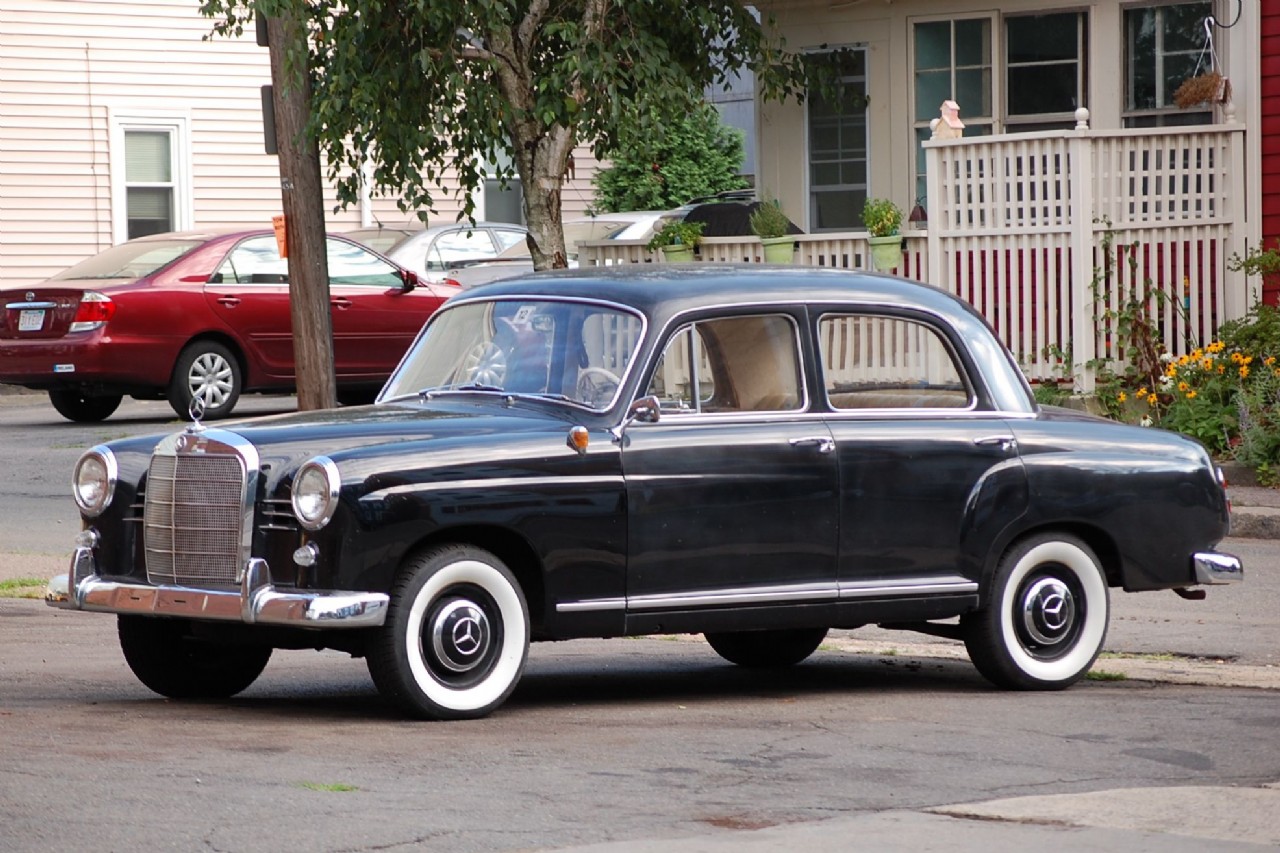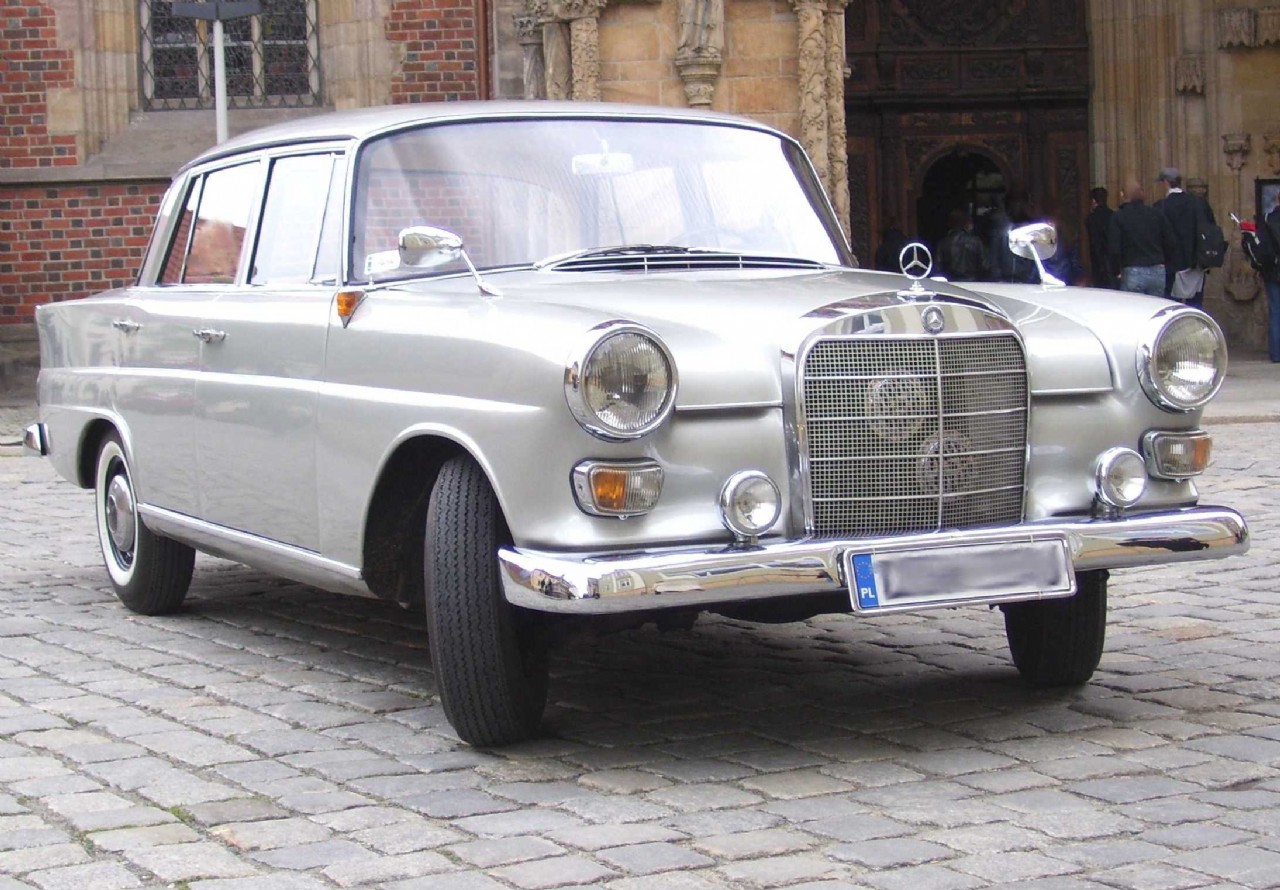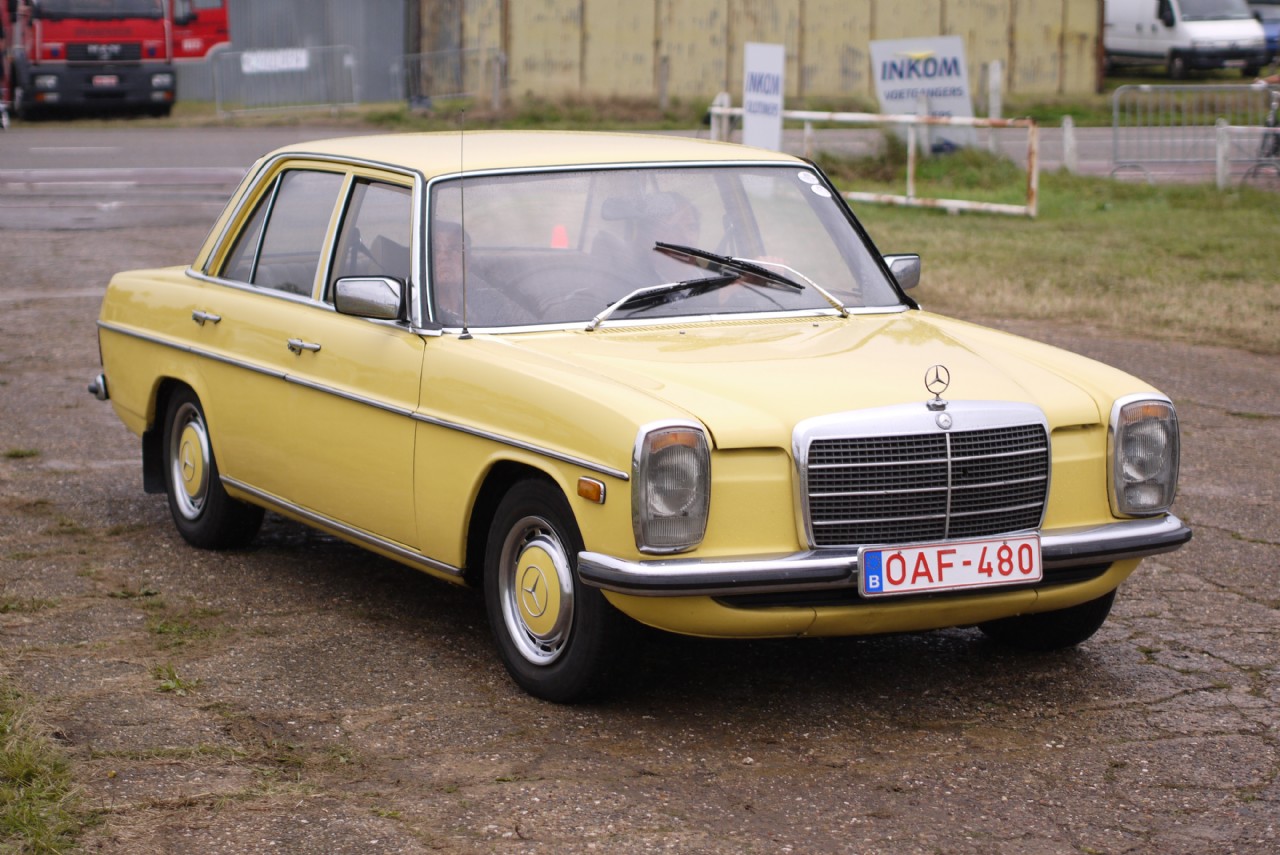
The Mercedes-Benz E-Class is a range of executive cars manufactured by German automaker Mercedes-Benz in various engine and body configurations. Produced since 1953, the E-Class falls midrange in the Mercedes line-up, and has been marketed worldwide across five generations.
Before 1993, the E in Mercedes-Benz nomenclature was a suffix following a vehicle's model number which stood for Einspritzmotor (German for fuel injection engine). It began to appear in the early 1960s, when that feature began to be utilized broadly in the maker's product line, and not just in its upper tier luxury and sporting models. By the launch of the facelifted W124 in 1993 fuel-injection was ubiquitous in Mercedes engines, and the E was adopted as a prefix (i.e., E 220) and the model line referred to officially as the E-Class (or E-Klasse). All generations of the E-Class have offered either rear-wheel drive or Mercedes' 4Matic four-wheel drive system.
Historically, the E-Class is Mercedes-Benz' best-selling model, with more than 13 million sold by 2015. The first E-Class series was originally available as four-door sedan, five-door station wagon, 2 door coupe and 2 door convertible. From 1997 to 2009, the equivalent coupe and convertible were sold under the Mercedes-Benz CLK-Class nameplate; which was actually based on the mechanical underpinnings of the smaller C-Class while borrowing the styling and some powertrains from the E-Class, a trend continued with the C207 E-Class coupe/convertible which was sold parallel to the W212 E-Class sedan/wagon. With the latest incarnation of the E-Class released for the 2017 model year, all body styles share the same W213 platform.
Due to the E-Class's size and durability, it has filled many market segments, from personal cars to frequently serving as taxis in European countries, as well special-purpose vehicles (e.g., police or ambulance modifications) from the factory.

The first modern midsize Mercedes was the W120 'Ponton' 180 of 1953 and was produced until 1962. Sharing its engineering with the R121 190 SL of 1955, the Ponton was a stylish sedan with a four-cylinder engine. A larger-engined W121 190 appeared in 1958.

Mercedes added tailfins to both the big S-Class and the new W110 'Fintail' 190 of 1962. In the 1965 230 model a Straight-6 engine appeared for the first time, and the four cylinder engine grew in displacement.

The popular W123 quickly became a best-seller on its launch in 1976. Especially in diesel powered 200D and 240D (also the five-cylinder 300D) guises, the cars enhanced the company's reputation for product quality. Over 2.6 million were produced until the end of production in 1986. Saloon/Sedan, Coupé and Estate body configurations were offered.
The W124 was presented in 1984 and introduced several new standards for a mid-size Mercedes. It was the third car to inherit the company's new design theme since the late 1970s, following the flagship W126 and compact W201.
Similar to its predecessors, the W124 also offered a coupé and estate body styles. A new convertible (internally A124) was also available, making it the first mid-size Mercedes convertible.
The "E-Class" name first appeared with the facelifted W124 in 1993 for the model year 1994 (the W124 was introduced in 1984 but continued with the older naming convention until 1993, when all Mercedes-Benz models switched to a new system, e.g. E 320 instead of 300 E). The diesel versions continued to be the fuel economy option over the four and six-cylinder gasoline engines, and the gasoline V8 engines (available after 1992) increased gasoline power outputs further. Four-cylinder gasoline models were not marketed in the United States. The V8 powered sedans/saloons were named 400 E/500 E from 1992–1993, and E 420/E 500 after 1993. Likewise, the 3.0-litre cars (e.g. 300 E) were also re-badged to E 320 with the new 3.2-litre M104 engines and naming rationalization of 1994. For the diesel models the name change was less elegant, with the 250 D becoming the E 250 Diesel for example.
Sedan (W124), Coupé (C124), Convertible (A124) and Estate (S124) body configurations were offered.
The W210 E-Class, launched in 1995, brought the line firmly into the upper end of the mid-size luxury market.
Starting in 1996, the E-class made major changes compared to the earlier version of the E-class, including four large oval headlights, that gave Mercedes an updated image intended to attract more younger buyers and women. The new E-class was 1.6 inches longer and 2.3 inches wider and offered significantly more interior room but was still considered mid-size.
In September 1999 the W210 E-class was facelifted. This included visual, mechanical and quality improvements over the earlier versions.
The Mercedes-Benz E-Class was Motor Trend's Import Car of the Year for 1996.
While the W210 sedan was replaced by the W211 in 2002, the wagon version continued to be sold until March 2003 when the S211 wagon replaced the S210 wagon.
Launched in 2002, the W211 E-Class was another evolution of the previous model.
The W211-based C219 CLS-Class sedan was introduced as a niche model in 2005, primarily to attract a younger demographic.
The W211 E-Class was facelifted in June 2006 for the 2007 model year to address quality and technical issues raised by earlier models, Sensotronic was dropped, while Pre-Safe (w/o brake support) was made standard. The largest factory built engine in the E-class range is the E500 (badged E550 in the U.S.) which had its engine size increased from 5 litres to 5.5 litres in 2006 along with the facelift. There is also an AMG model badged E63 AMG and other tuning house installations.
The W212 replaced the W211 in 2009 (as a 2010 model). Official photos of the W212 were leaked on the internet on 9 December 2008 ahead of its 2009 Geneva Motor Show unveiling. Scans of a leaked brochure were posted onto the internet in January 2009, detailing the whole E-Class range including the new E 200 CGI and E 230 CGI with direct injected forced inducted engines. New features included a blind spot monitor, Lane Keeping Assist, Pre-safe with Attention Assist and Night View Assist Plus. In the United States the E-Class was priced nearly US$4,600 less than the previous model. The W212 estate was also announced and available from November 2009.
In 2013, the E-Class was comprehensively facelifted, featuring significant styling changes, fuel economy improvements and updated safety features. Daimler invested close to €1 billion into the development of the extensive refresh, making it likely the most expensive mid-life facelift in the history of the automobile. The biggest change was the singular front lights replacing the twin headlamp design (marking the end of Mercedes's dual headlamps use) with integrated LED DRLs. Although not an all-new model, the W212 facelift was the only mid-cycle refresh featured on a family portrait of several generations of the E-Class side by side by Mercedes-Benz for the unveiling of the W213 E-Class. While the factory has rated the E63S model at 577hp/590 tq, there is significant real-world dynamometer testing that indicates the AMG-tuned S model exceeds 600hp at the flywheel.
The coupé (C207) was first shown at the 2009 Geneva Motor Show, while the convertible (A207) was unveiled at the 2010 North American International Auto Show. Both models replaced the previous C209/A209 CLK-Class models. The C207/A207 E-Class is based on the W204 C-Class platform, and are produced alongside each other in the Bremen plant.
The fifth generation E-Class was unveiled at the 2016 North American International Auto Show. The next generation E-Class has design cues from the smaller W222 S-Class and the larger W205 C-Class. While the W212 E-Class has tighter surface and harder edges, the new model is curvier and more flowing.
Engine options for the W213 E-Class will see a major update, thanks to the switch to inline-6 engines from the current V6 engines, along with a new generation of four-cylinder diesel engines, codenamed OM654, and existing four-cylinder petrol engines.
The W213 E-Class is the second most technologically advanced Mercedes after the new S Class. The E-Class received the latest in autonomous driving technology for use at highway speeds, capable of piloting itself up to speeds of 130mph (210km/h) for up to 2 minutes. The system uses a complex array of motion sensors, radars and cameras to scan the road ahead, and requires the driver's hands to be placed on the wheel at all times. This feature was also available on the 4th generation Mercedes-AMG E 63 model.
In 2020, Mercedes-Benz introduced a facelift to the W213. Body styles will remain the same. The base model comes with the sporty Avantgarde Line exterior. One of the most notable changes in the interior is the new steering wheel. It now has no buttons, using only touch-pads for input. Another mode of input for the revolutionary MBUX system is a touch-pad in the centre console. MBUX, like other Mercedes-Benz vehicles is included for the first time in the E-Class. The base model will have a 4-cylinder paired to Mercedes-Benz's 9G-TRONIC transmission. ENERGIZING comfort and ENERGIZING coach, will be available on the E-Class. Mercedes-Benz says-"ENERGIZING comfort control networks various comfort systems in the vehicle, and uses musical and lighting moods plus a number of massage modes for a wide range of feel-good programmes. The “PowerNap” programme is available in the plug-in hybrids, which is useful when taking a break from driving at a rest area or when charging the battery en route, for example. The programme has three phases – falling asleep, sleeping, waking – and can enhance the performance of the driver and provide new energy. The ENERGIZING COACH is based on an intelligent algorithm, and recommends one of the programmes suited to the individual and situation. If a Garmin® wearable is integrated, personal values such as stress level or quality of sleep optimise the accuracy of the recommendation. The aim is for passengers to feel well and relaxed even during demanding or monotonous journeys."
Calendar US Europe
year sales sales
2001 - 44,445 - 128,208
2002 - 42,598 - 156,317
2003 - 55,683 - 191,809
2004 - 58,954 - 171,071
2005 - 50,383 - 125,348
2006 - 50,195 - 110,494
2007 - 48,950 - 109,872
2008 - 38,576 - 77,661
2009 - 43,072 - 100,947
2010 - 60,922 - 139,192
2011 - 62,736 - 129,963
2012 - 65,171 - 98,142
2013 - 69,803 - 106,559
2014 - 66,400 - 99,565
2015 - 55,888
2016 - 50,896
2017 - 51,312
2018 - 46,422
Published: Sunday, October 4, 2020 Viewed 96 times.
96 times.
Ask me about:

Askme / 10/4/2020 6:23:58 AM (Original: 1280X890 px)

Askme / 10/4/2020 6:32:08 AM (Original: 1280X853 px)

Askme / 10/4/2020 6:32:48 AM (Original: 1280X855 px)
Looking to upgrade your Mercedes GLK 350? Discover recommended performance upgrades that can enhance your vehicle's power and efficiency without sacrificing mileage.
/ Mercedes GLK 350 mileage and performance upgrades Answers: 0 1664
1664
Discover the key features of the Harley Davidson Freewheeler and how it stacks up against other motorcycles in its class. Find out which makes it stand out.
/ Harley Davidson Freewheeler Answers: 0 1165
1165
Learn about the essential maintenance tasks for your Mercedes-AMG GLC 43 SUV based on its recommended schedule to keep it running smoothly.
/ Mercedes-AMG GLC 43 SUV maintenance schedule Answers: 0 1020
1020
Discover the key features and specifications of the Harley Davidson Ultra Limited touring motorcycle, including powerful engine, comfortable seating, and advanced technology. Find out more here.
/ Harley Davidson Ultra Limited Answers: 0 1109
1109
Learn the essential tips for maintaining automatic transmission fluid to keep your vehicle running smoothly for years to come. Proper maintenance is key!
/ automatic transmission fluid maintenance tips Answers: 0 985
985
Cost to replace motor mounts on an Audi A6 can vary, but typically ranges from $300 to $600. Prices may vary depending on location and chosen repair shop.
/ Audi A6 motor mount replacement price Answers: 0 1032
1032
Looking for a pre-owned Mercedes GLK 350? Find out the current odometer reading of the vehicle you're interested in at the lot.
/ Mercedes GLK 350 odometer reading Answers: 0 1012
1012
Looking for a trustworthy mechanic near you to replace the engine mount in your Audi A6? Find reliable professionals with expertise in Audi repairs.
/ Audi A6 engine mount replacement mechanic near me Answers: 0 1030
1030
Discover the oil capacity and recommended type for a Mercedes-Benz GLC 43 AMG. Keep your luxury SUV running smoothly with the right oil specifications.
/ Mercedes-Benz GLC 43 AMG oil capacity and type Answers: 0 1156
1156
Discover the average durability of a Mercedes GLK 350 in miles before major mechanical issues typically occur. Make an informed decision for your next vehicle purchase.
/ Mercedes GLK 350 durability in miles Answers: 0 1025
1025
Learn how to adjust the drive belt on your John Deere lawn tractor correctly to improve performance and prevent slipping issues. Follow these steps for optimal functioning.
/ Adjusting the drive belt on a John Deere lawn trac Answers: 0 505
505
It's important to avoid hard acceleration and braking while driving to prevent accidents, reduce wear and tear on your vehicle, and improve fuel efficiency.
/ avoiding hard acceleration and braking Answers: 0 504
504
Discover the average miles per gallon for a Mercedes GLK 350. Get insights on fuel efficiency and make an informed decision before hitting the road.
/ Mercedes GLK 350 miles per gallon Answers: 0 478
478
Learn how to adjust the drive belt on a John Deere mower with these easy steps. Regular maintenance should be done to ensure optimal performance.
/ Steps for adjusting John Deere drive belt Answers: 0 502
502
Learn why synthetic oil is recommended for peak performance in a Mercedes-AMG GLC 43 and which specific type is best suited for this high-performance vehicle.
/ Synthetic oil for Mercedes-AMG GLC 43 Answers: 0 472
472
tepte.com: Your Questions and Answers Resource with a Wealth of General Knowledge
Are you seeking a one-stop destination for comprehensive knowledge and answers to your burning questions? Look no further than tepte.com! Our platform is your go-to source for a wide range of information, all conveniently presented in an easily accessible question and answer format.
At tepte.com, we pride ourselves on being your reliable knowledge hub. Whether you're curious about technology, science, history, or any other subject under the sun, our extensive General Knowledge (GK) knowledge base has you covered. We've made it our mission to provide you with in-depth insights and facts on an array of topics. Read more